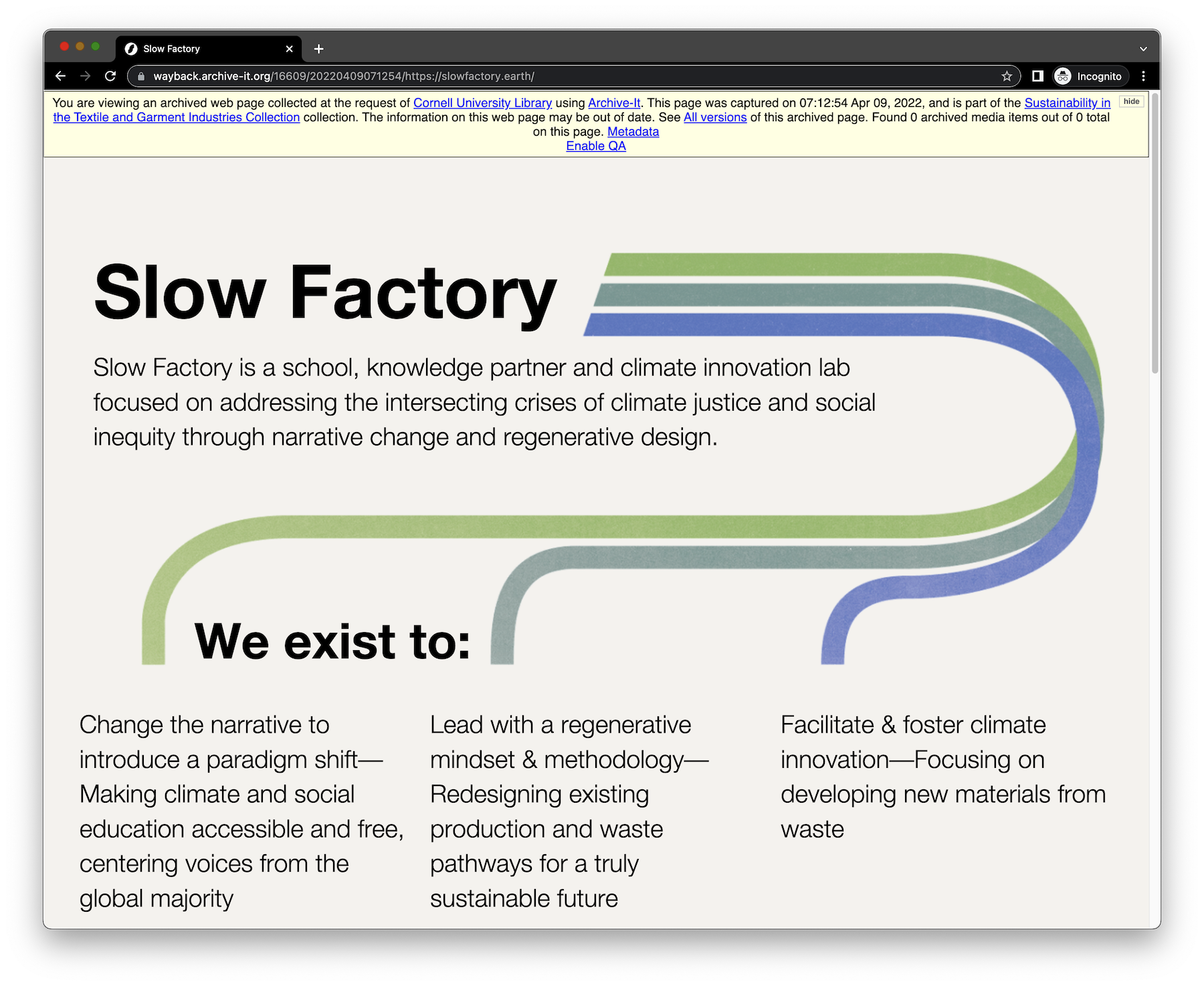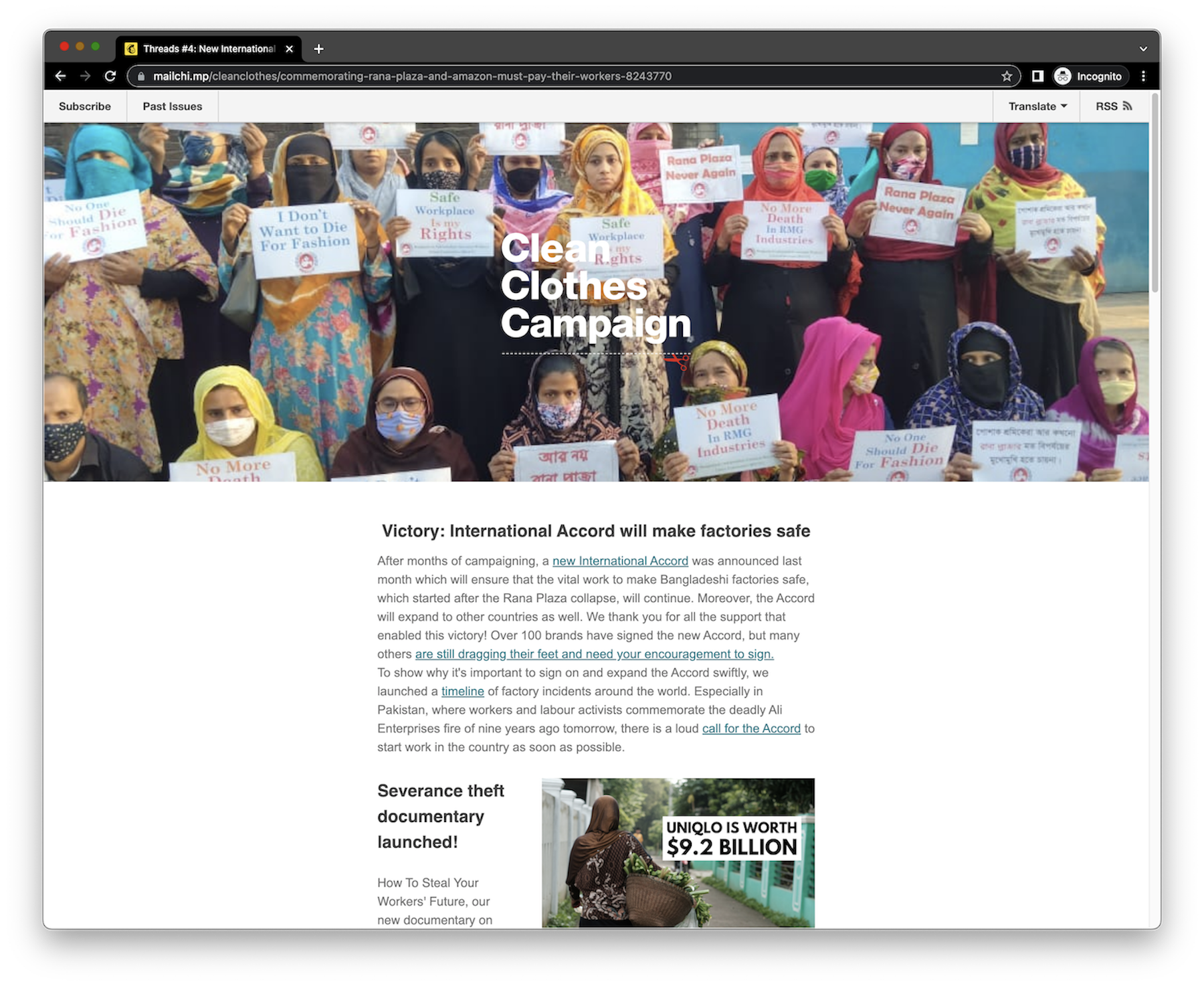A Stitch in Time: Preserving Websites Related to Sustainability in the Fashion Industry
April 18th, 2023
by Marcie Farwell, Textile Industry Curator, Kheel Center for Labor-Management Documentation and Archives, Cornell University and Michael Fleming, Web Archiving Technician, Cornell University
Marcie: When the former American Textile History Museum (ATHM) in Lowell, Massachusetts closed in 2016, the Kheel Center for Labor-Management Documentation and Archives at Cornell University acquired the bulk of its library and archives documenting the textile industry in the Northeastern United States from the early 19th though the mid-20th Centuries. In 2017, eight tractor-trailers carrying over 5000 cubic feet of archival materials and tens of thousands of books arrived at Cornell. The Kheel Center acquired these collections because of its extensive records related to textile and garment unions, and with the addition of the ATHM, it now has the records on both sides of the Labor-Management divide.
It can be hard to imagine in this digital age just how the textile industry defined America. From the enslaved people who grew the cotton that fed the factories in the North, the waves of immigrants who worked in the mills, to the barons of industry whose names can still be found on the map in places like Lowell and Lawrence, we can trace much of this country’s and its institutions’ wealth to the production of textiles.
The records of these textile companies form the vast majority of the collections that came from ATHM – boxes of paper records, map case folders of plans, drawings, and photographs, and ledgers the size of atlases. Here, we can find resources about the rise and eventual fall of that industry in the United States. However, access to the kinds of records of family-owned companies that had come into the ATHM are now less likely in a global age where companies have merged into mega-corporations, with textiles only a small piece of a larger whole. In order to document where the textile industry in the United States is now, we had to start with the websites of the textile and garment companies, both large and small, that still operate here. As smaller companies fold and larger firms merge, these websites are at risk of disappearing, therefore, in 2019, we created the first web archiving project related to the ATHM collections. The Textile and Garment Industries Collection currently has 195 sites related to these industries in the United States. As we were building that collection, we realized that some of the companies were part of the growing “slow fashion” movement that, like the slow food movement, seeks to build more sustainable garment and textile supply lines and products.

Screenshot of the Slow Factory website archived on April 9, 2022.
In 2015, the United Nations launched the 2030 Sustainable Development Goals (SDGs). The UN SDGs take a broad view of sustainability; connecting the need to address the environmental causes of climate change to the human cost of issues such as hunger, inadequate housing, poverty, and equal access to education. We now recognize the role of the textile industry in climate change and its long legacy of social and environmental harm. In the records of the ATHM and the related unions we see evidence of environmental pollution created by these industries, as well as unfair wage and working conditions leading to poverty, disease, and death. Sadly, though regulations in this country have improved working and environmental conditions, the worst issues were exported over the last half century as the industry moved across the globe.
According to a study by the United Nations Environmental Program and the Ellen MacArthur Foundation, the numbers are pretty daunting. The fashion industry (both textiles used for clothing and garment production) accounts for 10% of annual global carbon emissions, and this number is expected to grow by more than 50% by 2030. Around 20% of wastewater worldwide comes from fabric treatment and dying. And in a world increasingly running out of drinking water, the fashion industry uses enough water annually to meet the needs of 5 million people. Additionally, washing textiles is a major contributor to microplastics in the oceans, which has growing environmental and health effects. Sadly, all this waste might be for nothing since we don’t even wear the clothing made. In wealthy countries like the US, clothing is worn 36% less before it goes unused compared to 15 years ago. In China that number is an astounding 70%. And what we don’t use tends to be thrown away — of the total fiber input used for clothing, 73% is incinerated or disposed of in a landfill.

Screenshot of the Fibershed website archived on April 11, 2022.
As overwhelming as these numbers can feel, there are individuals, organizations, and companies that are attempting to change the industry for the better. The Sustainability in the Textile and Garment Industries Collection attempts to collect the websites of some of those change-makers since most of this work is being documented online. The first phase of the project collected sites related to sustainability non-profits such as Fashion Revolution, Responsibility in Fashion, and the Clean Clothes Campaign, some of which have been working for improved standards and transparency for decades. We also collected the sites of Fibersheds, a national organization of fiber producers, farmers, designers, and others dedicated to creating local fiber economies across the United States. The second phase of the project will collect more sites related to sustainable brands. This documentation can be difficult as many brands engage in greenwashing – creating marketing campaigns making it seem as though they are more environmentally conscious than they actually are. In addition to evidence of a true growing consciousness about the need to make clothing production more environmentally sound, the preservation of these sites may also serve to document this type of greenwashing behavior by brands.

Screenshot of the Clean Clothes website’s post about the International Accord to make Bangladeshi Factories safe after the Rana Plaza collapse.
April 24th, 2023 will be the 10th anniversary of the Rana Plaza collapse in which killed 1,134 people and injured 2500, most of them garment workers. Clothing is something nearly every person on the planet has a relationship with and we all have a stake in a solution to fashion’s sustainability problem. This conversation is constantly evolving, by capturing this moment and continuing to document it moving forward we offer future scholars a glimpse into action against climate change during this critical time.
Technical
Michael: Cornell University Library started web archiving in 2011 and since then has archived 6,783 websites covering 11.1 TB of data across 21 distinct collections. Cornell University has a history of creating thematic collections beginning in the first year of our program. Both textile collections are crawled semiannually to help future users see these organizations as they evolve and respond to changes in the industry.
Each collection is given a MARC record in our catalog, directing users to Archive-It, where the individual websites are cataloged. Metadata for each website was gathered early in the process by those selecting websites for inclusion in the collections. By uploading this metadata shortly after the first crawls began, users are more easily able to discover and navigate the collection without waiting for a cataloger to later review the collection. Each website is given a full quality assessment to identify any missing content.
Both collections continue to grow and evolve, mirroring the industry they are documenting. New websites are added to each collection throughout the year as identified by selectors. To date, the collections are comprised of 312 GB of data, and are growing at a rate of around 110 GB per year. We look forward to continuing to working on expanding both collections.

